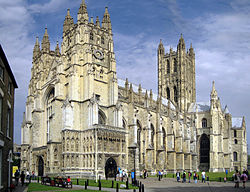Description and history
St. John's Episcopal Church is located west of downtown Bridgeport, its complex occupying part of a block bounded on the north by Laurel Avenue, the south by Fairfield Avenue, and the east by Park Avenue. The church building is arrayed with its long axis along Park Avenue, with its main facade facing south toward Fairfield Avenue. The church is a Gothic Revival structure, built out of granite quarried at Greenwich, Connecticut with lighter-colored trim from Ohio. It is roofed with dark slate tiles with bands of red slate. At the southeast corner stands a square tower, with stone buttresses at its lower level, a belfry at the second stage, and a pyramidal cap that has rounded turrets at the corners. Main entrances to the building are located in the base of the tower, with a matching entrance in a lower projection on the left side of the main block. [2]
The congregation of St. John's was organized as an Anglican mission in 1738, and is one of the oldest Episcopal congregations in the state. It was formally recognized as a parish in 1784. The present building is its fourth sanctuary, the congregation having outgrown each of the first three to be built. The church was designed by James Renwick Jr., a leading practitioner of church design in the late 19th century best known for St. Patrick's Cathedral in Manhattan. The church was built in 1873-75, its chapel wing on the north side was added 1886-1888, and the rectory was built in 1903. The parish hall/guild hall complex was built in 1930. The church altar is adorned by a reredos created by sculptor Gutzon Borglum and installed in 1913. [2]
This page is based on this
Wikipedia article Text is available under the
CC BY-SA 4.0 license; additional terms may apply.
Images, videos and audio are available under their respective licenses.



